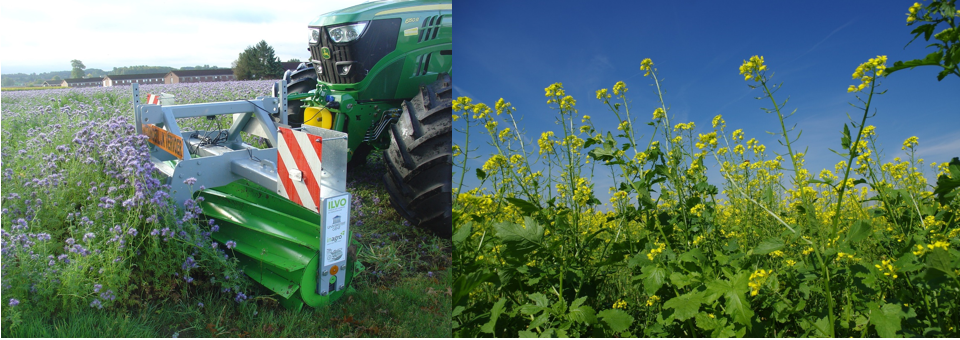
https://ec.europa.eu/eip/agriculture/en/find-connect/projects/bovine-beef-innovation-network-europe
To reduce nitrogen losses, one issue could be the re-connection between livestock and crop. Introduction of cover crops in the rotation to feed the herd and catch the nitrogen in the soil could be a solution. A cover crop is a type of crop planted during or after the growth period of the main crop and worked before sowing the next main crop. In short term, cover crops can counteract N leakage after the main crop, reduce erosion, increase evaporation, etc. In the long term, the conservation and build up of hummus and organic C-level leads to an increased soil life and a better soil structure and mineral management. This all helps to increase the yield of the crops following. In addition, cover crops have the property of fixating N, leading to a lower amount of manure needed and less N will be leached and pollute nearby water courses.
The analysis of Adalla et al. (2019) demonstrated that cover crops significantly (p < 0.001) decreased N leaching and significantly (p < 0.001) increased SOC (soil organic carbon) sequestration without having significant (p > 0.05) effects on direct N2O emissions. Cover crops could mitigate the NGHGB (net GHG balance) by 2.06 ± 2.10 Mg CO2‐eq ha−1 year−1. One of the potential disadvantages of cover crops identified was the reduction in grain yield of the primary crop by ≈4%, compared to the control treatment. This drawback could be avoided by selecting mixed cover crops with a range of legumes and non‐legumes, which increased the yield by ≈13%. These advantages of cover crops justify their widespread adoption.
However, to increase the effectiveness of cover crops, field management techniques should be optimized to the local climatic conditions, water resources, soil and cropping systems. The genetics of cover crop species could be improved to provide deeper rooted crops, which have higher N use efficiencies, better nitrate scavenging abilities and lower N leaching potential. Deep rooted species could help with cover crop resilience, for example deeper delivery of C in the soil profile. It is also important to adjust timings and dates of the planting and kill of the cover crops, to avoid competition with the primary crop, to improve their effectiveness and avoid trying to establish cover crops when soil conditions are sub-optimal

Use
Cover cropping can comprise a single species or a mixture of species and can use annual, biennial or perennial vegetation. Cover crops can be killed (or ploughed‐in) in winter or spring, or grazed, and incorporated in soils by tillage to prevent competition with the primary crop, and to promote mineralization of organic N. They can also be left on the soil surface over the fall and winter periods, until a primary crop in no‐till is planted, to provide weed control and N inputs.
Different types of cover crops:
- Legumes (e.g. alfaalfa, vetches and clover)
- Non-legumes (e.g. spinach, canola and flax)
- Grasses (e.g. ryegrass and barley)
- Brassicas (e.g. radishes and turnips)
Legume cover crops can be used as a green manure, to improve soil nutrition for the primary crop. In addition, they have the ability to fixate N and increase soil organic matter. Non-legume cover crops can fix and excess of N in the soil, increase crop biomass and improve soil quality. It is best to select a specific type of crop(s) based on the needs and goal of the farm.
Effects
- Direct: evaporation, protection against water/wind erosion, inhibition of weed development, organic nematode control
- Indirect: stable organic matter (hummus) for structure and fertility of the soil
Risks/Trade-offs
- Some studies showed competition of the cover crop with the primary crop for nutrients, soil moisture, and resulted in some loss of the grain yield
- Possible contamination with weed seeds
- Possible silage effect when insufficient ploughing
- Availability of N might come too late
- Extra labor for the ploughing
Impact on
- Socio-economic resilience: Catch crops could be valorized financially as fodder or for energy purposes, some regions provide a subside when cover crops are used, buying seeds for the cover crops will cost extra money, as the investment of extra labor is needed. These can be compensated for if the wider benefits are considered. These include retention and carryover of nutrients between phases of a rotation, and the opportunity for the cover crops to be sold as forage or grazed.
- Animal health and welfare: Catch crops are often grass. Grass fed beef is well appreciated by consumers on welfare perspective but also for the positive impacts on environmental indicators such as biodiversity, water quality, carbon sequestration, etc. Catch crops permit to produce more fodder, it is increasing fodder autonomy, increasing resistance of the farm fodder production to environmental hazards (more fodder produced).
- Production efficiency and meat quality:
- Environmental sustainability: The nitrogen concentration in the water wil decrease, better N fixation on field, less use of fertilizer
Sources
- Peyraud et al. (2012)
- Justes et al. (2012)
- Houot et al. (2014)